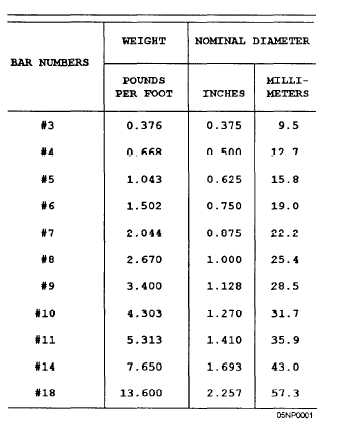is better than a plain round or square one. In fact, when
plain bars of a given diameter are used instead of
deformed bars, approximately 40 percent more plain
bars must be used.
The adherence of the concrete depends on the
roughness of the steel surface: the rougher the steel, the
better the adherence. Thus, steel with alight, firm layer
of rust is superior to clean steel, but steel with loose or
scaly rust is inferior.
Loose or scaly rust may be
removed from the steel by rubbing the steel with burlap.
The requirements for reinforcing steel are that it be
strong in tension and, at the same time, ductile enough
to be shaped or bent cold.
Reinforcing steel may be used in the form of bars
or rods that are either PLAIN or DEFORMED or in the
form of expanded metal, wire, wire fabric, or sheet
metal. Each type is useful for a different purpose, and
engineers design structures with these purposes in
mind.
Plain reinforcing bars are usually round in cross
section. They are used as main tension reinforcement
for concrete structures. They are the least used of the
rod type of reinforcement because they offer only
smooth, even surfaces for the adherence of concrete.
Reinforcing bars or rods are commonly referred to as
rebars.
Deformed bars are like the plain bars except that
they have either indentations in them or ridges on them,
or both, in a regular pattern. The twisted bar, for
example, is made by twisting a plain square bar cold.
The spiral ridges along the surface of the deformed bar
increase its bond strength with concrete. Other forms
used are the round- and square-corrugate d bars. These
bars are formed with projections around the surface that
extend into the surrounding concrete and prevent
slippage. Another type is formed with longitudinal fins
projecting from the surface to prevent twisting. Figure
7-10 shows a few of the various types of deformed bars
available. In the United States, deformed bars are used
almost exclusively, while in Europe, both deformed and
plain bars are used.
There are 11 standard sizes of reinforcing bars.
Table 7-1 lists the bar numbers, weight, and nominal
diameters of the 11 standard sizes. Bars No. 3 through
No. 18, inclusive, are deformed bars. Remember that
bar numbers are based on the nearest number of 1/8 in.
(3. 175 mm) included in the nominal diameter of the bar.
To measure rebar, you must measure across the
roundsquare portion where there is no deformation.
Table 7-1.-Standard Reinforcing Bars
The raised portion of the deformation is not considered
in measuring the rebar diameter.
BENDS.— Frequently, it is required that
reinforcing bars be bent into various shapes. There are
several reasons for this. First, let us go back to the
reason for using reinforcing steel in concrete—to
increase the tensile and compressive strength of
concrete. You might compare the hidden action within
abeam from live and dead loads to breaking a stick over
your knee. You have seen how the splinters next to your
knee push toward the middle of the stick when you
apply force, while the splinters from the middle to the
opposite side pull away from the middle. This is similar
to what happens inside the beam.
For instance, take a simple beam (a beam
resting freely on two supports near its ends). The
dead load (weight of the beam) causes the beam to
bend or sag. Now, from the center of the beam to
the bottom, the forces tend to stretch or
7-7


